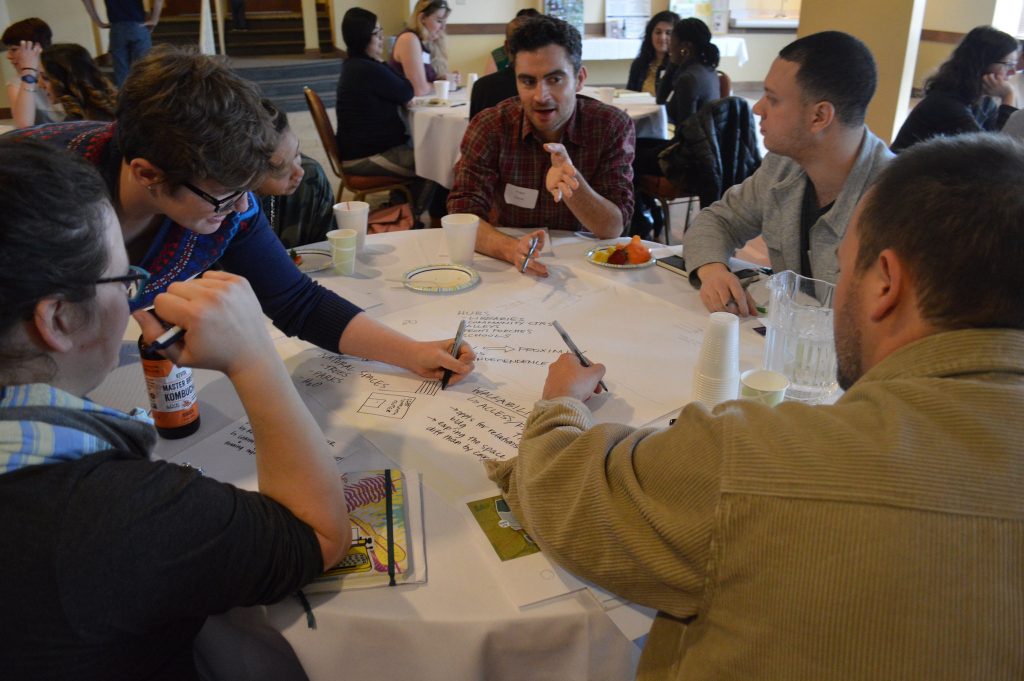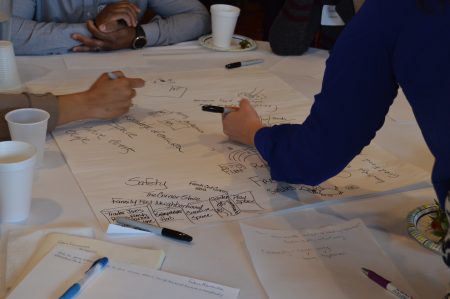Millennials Offer Vision for West Side
Diversity, safety, need for community center among the concerns.

Near West Side residents brainstorm the assets and concerns about the area. Photo by Alexandria Bursiek.
Millennials who attended a recent brainstorming session about the Near West Side said that they want improvements to be implemented in the area, but emphasized the need to avoid pricing out current residents.
“I do see a lot of change happening,” said Cold Spring Park resident Tiffany Miller, 37. “I want to make sure people of color are included in that process and remain in the neighborhood.”
Miller, who is African-American, said she attended the event because she wanted to know what the vision is for her neighborhood and to help shape it.
Area homeowners and renters between the ages of 17 and 45 were invited to discuss the future of seven neighborhoods on the Near West Side: Avenues West, Cold Spring Park, Concordia, Martin Drive, Merrill Park, Miller Valley and Piggsville. About 30 people who live or work in the neighborhoods attended.
The discussion was moderated by Christine Hill, executive director of Marquette University’s Future Milwaukee program, and the only baby boomer allowed at the event.
Among the major assets participants identified were the diversity of the neighborhoods, natural spaces and parks, local businesses and the historic buildings. MillerCoors, Harley Davidson,Aurora Health Care, Marquette University and the Potawatomi Business Development Corp. are all located in the area.

Participants write down and illustrate their ideas for the Near West Side. Photo by Alexandria Bursiek.
“I have always thought, ‘Wow this place is so diverse. Why don’t more people know about it and how can we do better?’” said Martin Drive resident LaToya Dennis. “I am here to do better.”
Jordan Donald, 28, said that although he does not live on the Near West Side, he attended because he wanted to participate in the conversation about what Milwaukee could be. “It needs a lot of fresh ideas and fresh perspectives. I think a lot of the things we’ve been doing aren’t necessarily working and it’s time to think outside the box a little bit and listen to the people who are most impacted by decisions,” added Donald. “Nobody knows the community better than the community itself.”
In addition to concerns about gentrification, the attendees raised issues of crime and the perception of crime in the Near West Side neighborhoods. They also spoke about empty storefronts and vacant lots as well as the lack of a strong sense of community.
“Safety is one of my biggest concerns right now,” said Miller. “There are a lot of children in my neighborhood and it would be awesome to have ‘safe space’ weekends where the streets are blocked off so kids can really play.”
Martin Drive resident Heather Braatz shared her concern about vacant lots. “There are a lot of vacant lots and if left vacant for a long time that becomes a problem,” she said, adding that residents should take the opportunity to invest in the properties.
Participants proposed building a community center that could be used to bring together diverse members of the community and serve as a place to exchange ideas and grow relationships.
“The community center would have resources for both homeowners and renters and be inclusive of different ethnic groups and maybe have a small-business focus,” said Braatz.
Mueller explained that the meeting focused on millennials because residents want to hear new opinions and ideas on how to improve the area. Mueller said that newer residents have been less involved.
After the discussion, participants were asked to rank their confidence in the Near West Side on a scale of one to five, with five being the most confident. According to Hill, the average ranking was four, compared to three before the event.
Maddick noted that she plans to pass on the participants’ thoughts and ideas to Near West Side Partners and the Marquette Office of Community Engagement. Maddick added that she would like to see the participants remain engaged in the community.
“It was a wonderful group of individuals that seemed to reflect the neighborhood,” said Hill. “[They are] diverse, energized and clearly interested in staying in this area and in enhancing what they see as assets.”
This story was originally published by Milwaukee Neighborhood News Service, where you can find other stories reporting on fifteen city neighborhoods in Milwaukee.
If you think stories like this are important, become a member of Urban Milwaukee and help support real, independent journalism. Plus you get some cool added benefits.






















If you are only going to allow one baby-boomer, Christine Hill was an exceptional choice to moderate! She’s light years ahead of traditional mover/shakers!
Rebuild the baseball field at Washington Park for use by MPS, MUHS and the neighborhood.
In terms of historic buildings, MillerCoors wants to demolish two of the city’s oldest brewing buildings, which were formerly part of Gettelman Brewery. They have been nominated for temporay historic designation.
http://www.jsonline.com/story/entertainment/beer/2017/04/07/historic-designation-sought-gettelman-brewery/100180242/
When you say millennials who are you talking about? If it is white millennials are they settling down. Their previous track record is to rent and to stay mobile in living. So, were talking about a more diverse group of millennials.
Whenever I hear comments about “gentrification” in significantly distressed neighborhoods in Milwaukee, of which there are many, I am confused. Milwaukee desperately needs reinvestment in our neighborhoods, it is disinvestment that is sucking the life out of once vibrant communities. Some of the most stunning housing stock in the city is in Sherman Park, please, anyone, become a homeowner there – your mortgage will be less than your rent. Diversity – yes, reinvestment – yes, a clean, safe, quiet neighborhood – yes, rising property values – yes. Is that gentrification? Is that bad for Sherman Park or other struggling neighborhoods?
I agree with several posters that it can be counterproductive to fear that all neighborhood reinvistment will cause “gentrification.” There are many tools that can be used to help ensure that neighborhoods can improve and while remaining home to people living there. However, it often requires thoughtful public policy and engaged citizens. For example, some cities limit the percentage residential property taxes can increase annually, to say three percent.
Here are some approaches for this that involve public spaces.
http://www.pps.org/reference/equity-placemaking-gentrification/
FYI, Mike M, at a recent meeting in Washington Park hosted by county officials, there was discussion about shifting the ballfield from baseball to soccer (and maybe other sports).
I love how the millennials were the only ones included. Keep out people who are long term residents or who have innovative ideas. Obviously this was not a serious undertaking otherwise they wouldn’t be discriminating because of one’s age. Bad precedent.
How could Washington Park become one of the focal points for bringing all of these west side communities together on a regular bases for the next 10 to 30 years? Think big!
Arts, fitness, aquatics, nature, music, sporting events, seasonal activities, concerts, picnics, facilities updates…
What would attract the Millenniels and major institutions located on the west side like to see?